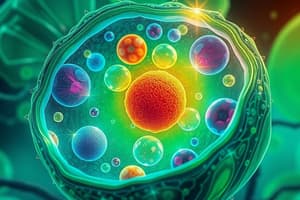Podcast
Questions and Answers
Which of the following structures is NOT directly involved in protein synthesis within a plant cell?
Which of the following structures is NOT directly involved in protein synthesis within a plant cell?
- Nucleolus
- Ribosomes
- Rough Endoplasmic Reticulum
- Mitochondrion (correct)
The middle lamella is a structure that cements together the cell walls of two adjoining plant cells.
The middle lamella is a structure that cements together the cell walls of two adjoining plant cells.
True (A)
What is the primary function of the plasmodesmata in plant cells, and how does this contribute to cell communication and coordination?
What is the primary function of the plasmodesmata in plant cells, and how does this contribute to cell communication and coordination?
Plasmodesmata are channels that allow direct cytoplasmic connections between plant cells, enabling the transport of water, nutrients, and signaling molecules for communication and coordinated function.
The plant cell organelle responsible for photosynthesis is the __________.
The plant cell organelle responsible for photosynthesis is the __________.
Match the following plant cell structures with their primary functions:
Match the following plant cell structures with their primary functions:
Flashcards
Middle Lamella
Middle Lamella
Outermost layer that cements adjacent plant cells together.
Intercellular Space
Intercellular Space
Spaces between plant cells, allowing for gas exchange.
Primary Cell Wall
Primary Cell Wall
The first cell wall layer formed in a growing plant cell.
Secondary Cell Wall
Secondary Cell Wall
Signup and view all the flashcards
Plasma Membrane
Plasma Membrane
Signup and view all the flashcards
Study Notes
- Key card for plant cell
Plant cell structures
- Middle lamella or intercellular layer is the outermost layer
- The primary cell wall is inside the middle lamella
- The Intercellular space is inside the primary cell wall
- Secondary cell wall is named fourth
- Plasma membrane surrounds the cytoplasm and organelles
- The Golgi body with vesicles are inside the plasma membrane
- Cytoplasm with organelles contain the components of the cell
- Rough endoplasmic reticulum is a membrane-bound organelle involved in protein synthesis and modification
- The nucleus houses the cell's genetic material
- The nucleolus is a structure within the nucleus where ribosomes are assembled
- Nuclear pores are openings in the nuclear envelope that control the movement of substances into and out of the nucleus
- Chromosomes carry genetic information
- The outer membrane of the nuclear envelope surrounds the nucleus
- The inner membrane of the nuclear envelope is inside the outer membrane
- Chloroplasts are the site of photosynthesis
- Mitochondria are the powerhouses of the cell, generating ATP
- Granum (plural grana) are stacks of thylakoids inside chloroplasts
- Plasmodesmata are channels that connect adjacent plant cells, allowing for communication and transport
- The chloroplast stroma is the fluid-filled space surrounding the grana inside chloroplasts
- The vacuole stores water, nutrients, and waste products
- Lysosome or peroxisome breaks down cellular waste and toxins
- The vacuolar membrane surrounds the vacuole
- Smooth endoplasmic reticulum synthesizes lipids and steroids, and also detoxifies the cell
- Ribosomes are responsible for protein synthesis
Studying That Suits You
Use AI to generate personalized quizzes and flashcards to suit your learning preferences.




